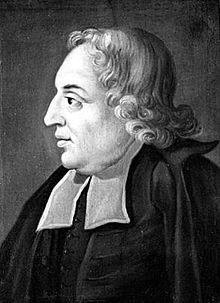Carlo Alessandro Guidi (14 June 1650 – 12 June 1712), Italian lyric poet, was born at Pavia.
Carlo Alessandro Guidi | |
|---|---|
 Portrait of Carlo Alessandro Guidi, c. 1700 | |
| Born | 14 June 1650 |
| Died | 12 June 1712 (aged 61) |
| Resting place | Sant'Onofrio, Rome |
| Occupations |
|
| Title | abbot |
| Parent(s) | Bernardo Guidi and Maddalena Guidi (née Figarolla) |
| Writing career | |
| Pen name | Erilo Cleoneo |
| Language | |
| Literary movement |
|
Biography
editAs chief founder of the well-known Roman Academy of the Arcadians, he had a considerable share in the reform of Italian poetry, which at that time was dominated by the baroque extravagance of the poets Giambattista Marino and Claudio Achillini and their school. Guidi, Giovanni Mario Crescimbeni, and the critic and jurisconsult Gravina attempted to foster a straightfoward use of language.[1]
While his early verse shows the influence of Marino, he later cultivated the Pindaric manner of Chiabrera, aspiring ambitiously to become the Pindar of his century, and seeking a noble eloquence in canzoni of free stanzaic form.
The genius of Guidi was lyric in the highest degree; his songs are written with singular force, and charm the reader, in spite of touches of bombast. His most celebrated song is that entitled Alla Fortuna (To Fortune), which was a much admired work of poetry in the 17th century.[1]
Guidi was squint-eyed, humpbacked, and of a delicate constitution, but possessed undoubted literary ability. His poems were printed at Parma in 1671, and at Rome in 1704. In 1681 he published at Parma his lyric tragedy Amalasunta in Italia, and two pastoral dramas Daphne and Endymion. The last had the honor of being mentioned as a model by the critic Gravina, in his treatise on poetry.[1]
Less fortunate was Guidi's poetical version of the six homilies of Pope Clement XI, first as having been severely criticized by the satirist Settano, and next as having proved to be the indirect cause of the author's death. A splendid edition of this version had been printed in 1712, and the pope being then in Castel Gandolfo, Guidi went there to present him with a copy. On the way he found out a serious typographical error, which he took so much to heart that he was seized with a stroke at Frascati and died on the spot.[1]
Guidi was honoured with the special protection of Ranuccio II, duke of Parma, and of Queen Christina of Sweden.
Works
edit- Poesie liriche d'Alessandro Guidi consagrate all'Altessa Serenissima di Ranuccio II Farnese duca di Parma, e di Piacenza. In Parma: per li Viotti, 1671
- Il Giove d'Elide fulminato, introduzione al balletto fatto dalla serenissima signora duchessa di Parma l'anno 1677. Nel teatrino del serenissimo signor duca poesia d'Alessandro Guidi, posta in musica da d. Marco Uccellini maestro di capella della medesima altezza, Parma, 1677
- Amalasonta in Italia. Dramma d'Alessandro Guidi, posto in musica dal Maestro di cappella Gio: Battista Policci, e fatto rappresentare dal serenissimo signor duca di Parma nel Teatro del Collegio de' Nobili l'anno 1681. In Parma: per Galeazzo Rosati Stampator Ducale, 1681
- Amore riconciliato con Venere, introduzione al balletto fatto dalla serenissima signora duchessa di Parma l'anno 1681. nel Teatrino del serenissimo signor duca poesia d'Alessandro Guidi, posta in musica dal Maestro di cappella Gio: Battista Policci. In Parma: per Galeazzo Rosati Stampator Ducale, 1681
- Accademia per musica fatta nel real palazzo della maesta della regina Christina per festeggiare l'assonzione al trono di Giacomo secondo re d'Inghilterra, versi d'Alesandro Guidi. In Roma: nella stamperia della Reu. Cam. Apost., 1687
- L'Endimione di Erilo Cleoneo pastore arcade con un discorso di Bione Crateo all'eminentiss. e reverendiss. sig. cardinale Albano. In Amsterdam: appresso la vedoua Schippers, 1692
- Pensieri heroici, spiegati dalla penna d'Alessandro Guidi. Dedicati all'illustrissimo Nicolò Foscarini. In Venetia: appresso Alvise Pavin, 1695; In Parma: per Giuseppe Rossetti, 1695
- Poesie d'Alessandro Guidi non più raccolte, con la sua vita novamente scritta dal signor canonico Crescimbeni e con due ragionamenti di Vincenzo Gravina non più divulgati, Verona, G. A. Tumermani, 1726
- Le basiliche di S. Francesco d'Assisi e della Madonna degli Angeli, descritte da Alessandro Guidi, postovi innanzi un compendio della vita di esso serafico padre. Roma: Tip. poliglotta, 1873
References
edit- ^ a b c d One or more of the preceding sentences incorporates text from a publication now in the public domain: Chisholm, Hugh, ed. (1911). "Guidi, Carlo Alessandro". Encyclopædia Britannica. Vol. 12 (11th ed.). Cambridge University Press. p. 687.
External links
edit- Lindon, John (2002). "Guidi, Alessandro". The Oxford Companion to Italian Literature. Oxford University Press. ISBN 978-0-19-818332-7. Retrieved 27 May 2023.
- Matt, Luigi (2003). "GUIDI, Alessandro". Dizionario Biografico degli Italiani, Volume 61: Guglielmo Gonzaga–Jacobini (in Italian). Rome: Istituto dell'Enciclopedia Italiana. ISBN 978-8-81200032-6.